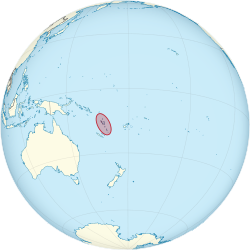Vanuatu
Vanuatu is a country in the Pacific Ocean. The official languages of Vanuatu are Bislama, English and French. In 2020, 300,019 people lived in Vanuatu.[5] The capital of Vanuatu is Port Vila. The country was ruled as a colony by England and France. It got its independence in 1980.[7] During the colonial time, it was named the "New Hebrides" or "Nouvelles Hebrides".
Republic of Vanuatu Ripablik blong Vanuatu (in Bislama) République de Vanuatu (in French) | |
|---|---|
| Motto: "Long God yumi stanap" (in Bislama) (In God we stand[1][2][3]) | |
| Anthem: "Yumi, Yumi, Yumi" (in Bislama) ("We, We, We") | |
 | |
| Capital and largest city | Port Vila 17°S 168°E / 17°S 168°E |
| Official languages | Bislama English French |
| Ethnic groups (1999) | Ni-Vanuatu 98.5% other 1.5% |
| Demonym(s) | Ni-Vanuatu; Vanuatuan |
| Government | Unitary parliamentary republic |
| Nikenike Vurobaravu | |
| Charlot Salwai | |
| Independence | |
• from France and the United Kingdom | 30 July 1980 |
| Area | |
• Total | 12,190 km2 (4,710 sq mi) (161st) |
| Population | |
• 2023 estimate | 335,908[4] (182nd) |
• 2020 census | 300,019[5] |
• Density | 19.7/km2 (51.0/sq mi) (188th) |
| GDP (PPP) | 2010 estimate |
• Total | $1.216 billion[6] |
• Per capita | $5,500 (2010 est.)[6] |
| GDP (nominal) | 2010 estimate |
• Total | $721 million[6] |
• Per capita | $2,835[6] |
| HDI (2004) | medium · 126th |
| Currency | Vanuatu vatu (VUV) |
| Time zone | UTC+11 (VUT (Vanuatu Time)) |
| Driving side | right |
| Calling code | 678 |
| ISO 3166 code | VU |
| Internet TLD | .vu |

History
changeEvidence shows, that people lived in Vanuatu by 1300 BC.[8] Portuguese explorer Pedro Fernández de Quirós first discovered the islands in 1606. British explorer, navigator James Cook discovered the islands in 1774. Cook mapped the islands and named them New Hebrides.[9][8]
Geography
changeVanuatu is an island archipelago. It has about 82 small islands. The islands were made from volcanoes. People live on 65 of the islands. There is about 800 miles (1,300 km) north to south distance between the outermost islands. Two of the islands (Matthew and Hunter) are also claimed by France. Fourteen of Vanuatu's islands are larger than 100 square kilometres (39 sq mi).
The highest point in Vanuatu is Mount Tabwemasana, at 1,879 metres (6,165 ft), on the island of Espiritu Santo.
Flora and fauna
changeEven though it has tropical forests, Vanuatu has a small number of plant and animal species. There are no large mammals. The 19 species of native reptiles include the flowerpot snake, found only on Efate. The Fiji Banded Iguana (Brachylophus fasciatus) was introduced as a feral animal in the 1960s.[10][11] There are 11 species of bats and 61 species of land and water birds.
The region is rich in sea life. There are more than 4,000 species of marine molluscs. Coneshell and stonefish carry poison that will kill humans. The giant East African land snail arrived only in the 1970s but already has spread from the Port-Vila region to Luganville.
There are three or possibly four adult saltwater crocodiles living in Vanuatu's mangroves and no current breeding population.[11] It is said the crocodiles reach the northern part of the islands after cyclones. This is because of the island chain's closeness to the Solomon Islands and New Guinea, where crocodiles are very common.[12]
Cuisine
changeThe national dish of Vanuatu is the lap lap.[13]
Locations
changeThere are six provinces in Vanuatu. They are Malampa, Penama, Sanma, Shefa, Tafea and Torba.
Some of the cities are:[14]
Famous People From Vanuatu
changeAdele Willie is a sports commentator.
Gallery
change-
Cinder plain of Yasur volcano on Tanna island.
-
National Cultural Centre, Port Vila.
-
National Council of Chiefs, Port Vila.
-
Stream on Efate island.
-
Port Villa street band.
-
Aerial view of Port Vila.
-
Early fire-making technique in Vanuatu.
-
North Efate.
References
change- ↑ Selmen, Harrison (2011-07-17). "Santo chiefs concerned over slow pace of development in Sanma". Vanuatu Daily Post. Retrieved 2011-08-29.
- ↑ John Lynch and Fa'afo Pat (eds), Proceedings of the first International Conference on Oceanic Linguistics, Australian National University, 1993, p. 319.
- ↑ G. W. Trompf, The Gospel is not Western: Black theologies from the Southwest Pacific, Orbis Books, 1987, p. 184.
- ↑ "Vanuatu Population (2023) – Worldometer". worldometers.info. Retrieved 2023-09-05.
- ↑ 5.0 5.1 "2020 National Population and Housing Census - Basic Tables Report, Volume 1, Version 2" (PDF). vnso.gov.vu. Vanuatu National Statistics Office. 2021-11-17. Archived from the original (PDF) on 2023-09-05. Retrieved 2023-09-05.
- ↑ 6.0 6.1 6.2 6.3 "Vanuatu". International Monetary Fund. Retrieved 2010-04-21.
- ↑ Swan, Quito J. (2020). Pauulu's Diaspora: Black Internationalism and Environmental Justice (1 ed.). University Press of Florida. doi:10.2307/j.ctv10kmbwz.7. ISBN 978-0-8130-5750-7. JSTOR j.ctv10kmbwz. S2CID 242264203.
- ↑ 8.0 8.1 "Vanuatu - History". Encyclopedia Britannica. Retrieved 2021-05-07.
- ↑ "Vanuatu profile - Timeline". BBC News. 2017-07-12. Retrieved 2021-05-07.
- ↑ Robert George Sprackland (1992). Giant lizards. Neptune, NJ: T.F.H. Publications. ISBN 0-86622-634-6.
- ↑ 11.0 11.1 Harewood, Jocelyn (2009). Vanuatu and New Caledonia. Lonely Planet. p. 47. ISBN 978-0-86622-634-9.
- ↑ Bennett, Michelle; Jocelyn Harewood (2003). Vanuatu. Lonely Planet. p. 19. ISBN 978-1-74059-239-0.
- ↑ The secrets of Vanuatu's national dish, the Lap Lap
- ↑ "Background Note: Vanuatu". Bureau of East Asian and Pacific Affairs. U.S. Department of State. April 2007. Retrieved 2007-07-16.

